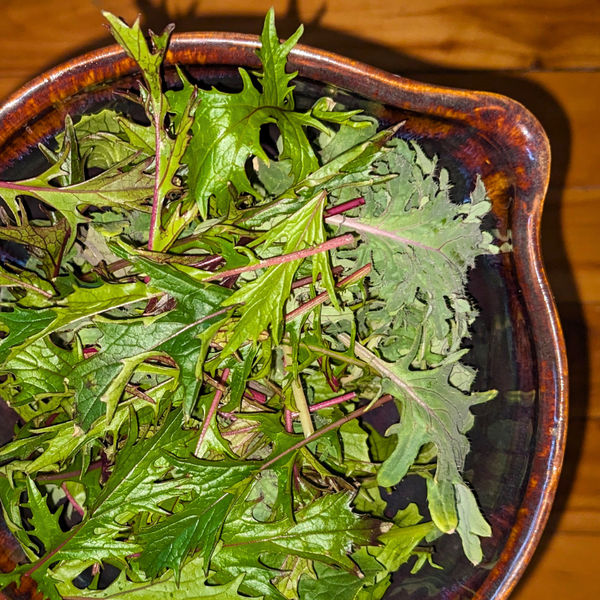Comme beaucoup de jardiniers, le jardin me manque vraiment au milieu de l'hiver. Je regrette de ne pas avoir de produits frais à cueillir et à ajouter aux repas, et de ne pas voir les légumes pousser. Alors, naturellement, j'amène un peu de mon jardin à l'intérieur.
Si vous avez déjà un espace de semis, il est très facile de le convertir pour faire pousser des jeunes pousses pour l'hiver. Si vous n'avez pas encore d'espace dédié à la culture, il n'est pas trop difficile de l'établir et la récompense de légumes verts frais tout l'hiver en vaut la peine. Voici comment je fais pousser les salades vertes de décembre à mars, jusqu'à ce qu'il soit temps de passer aux semis pour le printemps.
En théorie, avec suffisamment de lumière et d'espace, vous pouvez cultiver à peu près n'importe quoi à l'intérieur. Cependant, je suggère de vous en tenir aux jeunes pousses et aux herbes aromatiques. Si vous voulez essayer de cultiver des tomates naines ou d'autres plantes fruitières à l'intérieur, vous aurez besoin de contenants beaucoup plus grands pour l'espace racinaire, d'une alimentation beaucoup plus fréquente et d'une lumière très puissante pour le développement des fruits.
De quoi as-tu besoin:
- Une lampe de culture à spectre complet
- Un fan
- Mélange de potting
- Plateau de plantation ou de semis
- Bac à mailles (en option)
- Un engrais soluble dans l'eau
- Graines
Le ventilateur est essentiel, l'ajout d'un ventilateur vous aide à réussir en renforçant les plantes, en évitant les tiges longues et faibles et en fournissant un flux d'air qui maintient généralement les plantes en meilleure santé.
Si vous n'avez pas de bac de plantation en filet/drainant à remplir de terre et à placer à l'intérieur du bac d'arrosage, ne vous inquiétez pas. Si vous trouvez un sac de terreau qui rentre dans votre bac, vous pouvez planter directement dans le sac. Il suffit de secouer le sac de terreau pour briser les mottes et de lisser le sol en une couche uniforme. Ensuite, percez ou découpez des trous pour le drainage dans le fond du sac, placez-le dans le bac et découpez un rectangle dans le haut du sac en laissant un bord suffisant pour éviter de renverser de la terre.
Ne réfléchissez pas trop à la lumière ou à l'équipement, utilisez ce à quoi vous avez accès. Même une lampe blanche normale fournira suffisamment de lumière pour les jeunes pousses si vous la placez à environ 12 à 20 cm au-dessus des plantes. Vous n'avez pas besoin d'une lampe spécialement commercialisée pour la culture des plantes. Si vous avez déjà une lampe pour faire germer des graines, utilisez-la.
Cependant, il est utile que votre lampe soit équipée d'une minuterie intégrée. La minuterie de ma lampe de culture est réglée sur 10 heures par jour et le ventilateur fonctionne en permanence.

Arrosez abondamment le sol et saupoudrez vos graines dessus. Vous pouvez éventuellement disperser une fine couche de terreau réservé sur les graines, mais ce n'est pas strictement nécessaire. Vous pouvez regrouper les graines beaucoup plus près les unes des autres que ce que suggère le paquet, car vous avez l'intention de les récolter jeunes et non de faire pousser des têtes complètes de laitue ou de chou frisé, ce qui nécessiterait un espacement beaucoup plus important. Si vous avez des trous comme moi où moins de graines ont germé, remplissez-les simplement plus tard avec quelques graines supplémentaires.
Sélection des graines
J'ai eu le plus de succès avec les feuilles de moutarde, les choux frisés et la laitue romaine avec cette méthode. Comme vous récoltez les feuilles jeunes, vous n'avez pas à vous soucier de l'apparition de saveurs amères ou de textures désagréables, donc toutes les graines de feuilles que vous avez devraient bien fonctionner. J'en profite également pour faire pousser d'autres herbes comme le basilic et le persil, puis je les transplante dans une jardinière plus grande près de la fenêtre pour cuisiner pendant l'hiver.
Cutleaf Seeds propose quelques excellentes options pour les jeunes pousses ! Le chou frisé rouge russe, les feuilles de moutarde Mizuna, les feuilles de moutarde Scarlet Frills et toutes les graines de laitue sont toutes excellentes pour les jeunes pousses.
Récolte
Cette fois, il a fallu environ 20 jours entre la germination et ma première récolte. C'est assez rapide ! Les feuilles de moutarde ont mûri plus rapidement, donc ce premier bol de salade était principalement composé de feuilles de moutarde, et le suivant contenait beaucoup plus de chou frisé. Commencez par cueillir/couper les plus grandes feuilles et assurez-vous de laisser la base de chaque petite plante intacte pour qu'elle continue à pousser. De cette façon, vous pourrez obtenir de nombreuses récoltes de votre petit bar à salade.
Si vous remarquez que certaines feuilles commencent à jaunir, utilisez un engrais organique hydrosoluble très dilué. Elles devraient alors continuer à pousser de nouvelles feuilles. Lorsque vous arrosez ou nourrissez, essayez de ne pas verser d'eau sur les feuilles elles-mêmes, mais uniquement sur le sol. Vous devriez ainsi obtenir des jeunes pousses propres, prêtes à servir dans un sandwich ou une salade.
Vous faites pousser quelque chose à l'intérieur cet hiver ? Il est peut-être trop tôt pour commencer à semer vos tomates pour le printemps, selon l'endroit où vous vous trouvez, mais si vous avez envie de faire pousser des graines, essayez les légumes verts !






